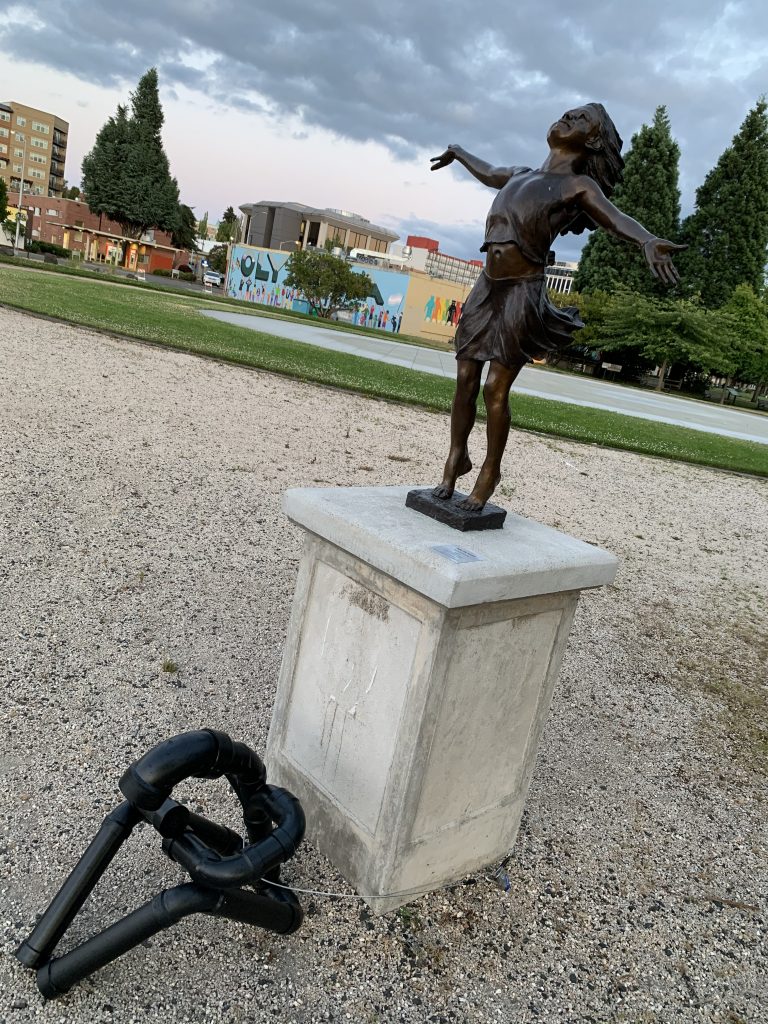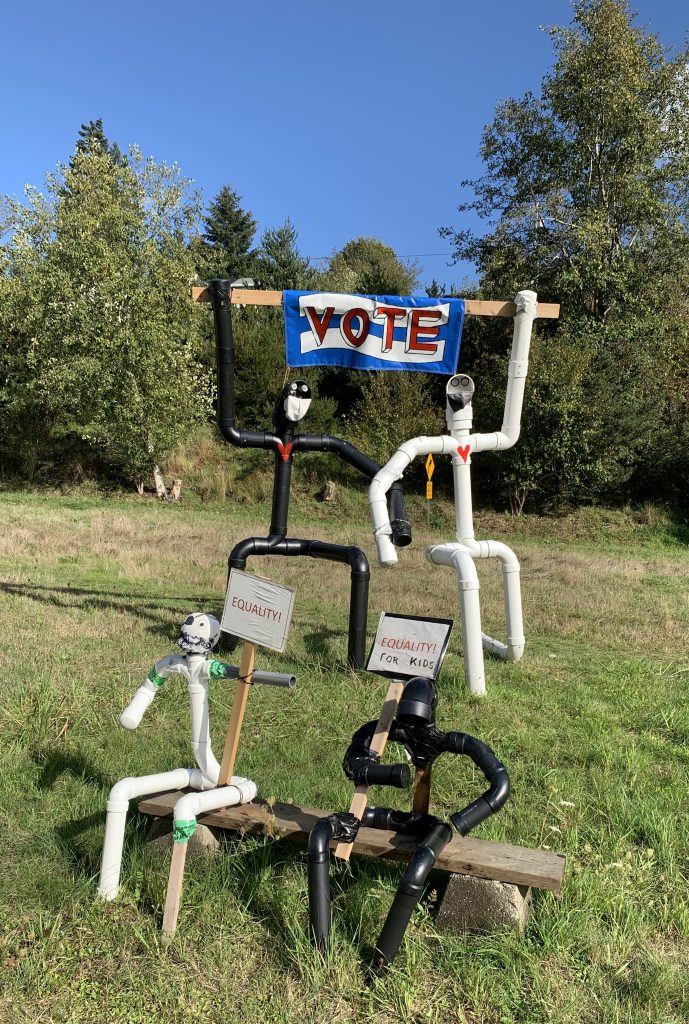In early July, I first saw one of the Little Brothers statues at twilight while driving across the Isthmus. My eyes were sweeping back and forth from the harbor to the Heritage Fountain in the fading light. Suddenly my eyes fixed on the small statue of the child near the fountain because it looked somehow different. Then I saw that in front of the statue’s pedestal was a small black figure.
Quickly, my eyes focused in to find a hunched over black figure constructed of pipe with its head in its hands. Normally, this statue is a sentimental tribute to childhood. But the pairing of the two figures was jarring – the statue of a little Caucasian girl throwing her arms wide open in joy while the black pipe figure looked like an African American child hunched over in abject despair.
I circled the block to get out of my car for a closer look and saw that this figure was chained to the base of the statue. While I figured the chain was intended to secure the piece, the image of bondage deepened the impact. And given the context of the ongoing Black Lives Matter protests across the country, this was clearly a statement on racism.

Later that month, I happened upon another piece installed on a hill near the intersection of San Francisco and East Bay Drive. This installation conveyed a very different relationship between black and white, with two larger than life size figures kneeling side by side in an expression of unified support for Black Lives Matter. Over the next few weeks, this installation evolved. First, the large figures were joined by two smaller figures, also black and white. Then they were outfitted with masks in a nod to public health. Later a banner reading, “We the People Created Equal” appeared in front of them and nearby a “Black Lives Matter” sign went up on posts.
A few days later I called a City official and learned that neither statues were part of the the City’s public art program. The mystery deepened. Who was placing these art pieces around the City? Was it an artist with a preference for industrial materials? Or perhaps a plumber with artistic tendencies?
Finally I got a clue from social media — someone posted about these statues and the artist. After a bit of screening, I was finally placed in direct contact with Anon, the chosen name of the artist.
I asked the artist what inspired these sculptures. Anon told me, “I was deeply angered about the police murder (of George Floyd) and figured I was too old to get tear-gassed, so I found a new way to protest.” While these sculptures started out as Anon’s personal expression, Anon quickly found that they had been widely embraced. “After the pieces had been up for a while, I realized it was about the community. I didn’t even think of it as my art anymore.”
Anon went on to describe the creation process of the sculptures called Brothers, both big and small. “I’ve been a life-long builder and had been working on a plumbing project. I thought to myself, ‘what a fun medium to work in’ and decided to use white PVC piping and Black ABS piping.”
Over the next month I watched as new Little Brothers appeared in various locations — near a westside Olympia roundabout, in Tumwater seated next to a Mark Twain sculpture and one nestled into the Westside Central Park Some of them were damaged or removed by vandals. Later, a few of them reappeared having been rescued by supporters.
“After one of the Little Brothers disappeared from the San Francisco Avenue hill, he was brought back by a neighbor,” said Anon. “Apparently, he (the sculpture) had been thrown into the East bay of Budd Inlet. Someone recognized where he belonged, and they repaired and re-installed the Little Brother.”
It was amazing to see that a broader circle of people were so invested in [these sculptures].Artist, Brothers
Clearly, these sculptures have become an unusual venue for public debate on race and Black Lives Matter. The community’s reaction reflects how we engage on such tough issues, with some people bent on destroying them and other devoted to keeping them in place. One of the constant refrains about the BLM protests, whether they involve sports stars taking a knee or local activists taking the streets, is that it’s “the wrong way to protest.” It would appear that some of the vandals have a similar reaction to these statues. But that doesn’t seem to slow Anon down, nor does it undermine the watchfulness of community supporters.
In my last exchange with Anon, I asked what the future holds for the Brothers, the answer went far beyond these anonymous sculptures. “The next four years will be the swan song for baby boomers, who have been divided between the idealism of the sixties and seventies versus the ‘What’s in it for me’ of the eighties and nineties. When the last white-haired male steps off the stage, we can only hope that younger generations will finally bury the racial and gender inequities that have afflicted our country.”
Wondering about the final statement from the statues themselves, I drove by the hill on San Francisco Street. According to a new sign, their final word was “VOTE.” Pretty straight forward — get out there and vote “equality” in the most significant election in decades. But driving away, I thought more about the image: coming together across our differences and voting. We each vote as an individual, but the next morning we emerge as a nation and must find a way to live with the results. The polarization inflamed by this election is worthy of its own anonymous statues, perhaps taking a cue from the Brothers by reminding us that equality will ultimately link us all.


Thank you, Anna.